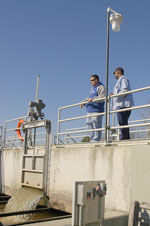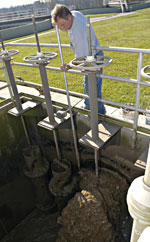8405 Cedar Creek Rd
Louisville, KY 40291
Recipient of the National Association of Clean Water Agencies (NACWA) Platinum Award for Operational Excellence.
The Cedar Creek Water Quality Treatment Center (CCWQTC) was originally designed as a 2.5 million gallons per day (MGD) facility. The treatment facility was constructed in 1995 to provide sanitary sewer service to the Cedar Creek Watershed. With the construction of this plant, many of the existing neighborhood package treatment plants that had a history of operational problems, were eliminated. The CCWQTC has played an important role in improving the water quality of the area by allowing for the regional treatment of wastewater.

Phase 1 construction of CCWQTC began in April of 1994 and was completed and accepting its first flow by May of 1995. Following completion of Phase 1, the treatment facilities included raw sewage pumping, a manually cleaned coarse bar screen, two mechanically cleaned bar screens, grit removal basin and grit separator, concentric channel oxidation ditch, two circular final clarifiers, traveling bridge sand filters, ultraviolet light disinfection, post aeration, return/waste sludge pumping, and aerobic sludge holding basin. Processing of waste sludge was and continues to be at MSD’s Morris Forman Water Quality Treatment Center (MFWQTC) with final effluent flowing from post aeration into Cedar Creek.
MSD’s Cedar Creek Action Plan (CCAP) contained the recommendation in 2000 to accelerate the expansion program from Phase 1 to the projected Phase 3 and construct a 7.5 MGD average design capacity. The second/third phase was under construction by June 2001 and completed by June 2003.

The expansion tripled facility capacity from 2.5 MGD to 7.5MGD. The influent pump station was replaced with 10 new pumps-2 small, 2 intermediate, and 6 large pumps. Methods were added to remove phosphorous (P) both biologically and chemically. There was an addition of one grit classifier, two mechanically cleaned screens, one manually cleaned bar screen, two new clarifiers, two new tertiary filters, and two new UV disinfection units.
The existing oxidation ditch was re-rated to 3.0 MGD and the second oxidation ditch with four channels was added to allow for biological phosphorous removal in the outer channel and to provide needed capacity. The plant has the capability of phosphorous removal using either a biological or chemical removal system.
The final design and construction cost was $12.56 million in 2003.
Currently, the raw wastewater is pumped by the influent pump station to the Preliminary Treatment Building where it is screened by one of four mechanically-cleaned bar screens. Wastewater then flows by gravity to one of two grit collectors to remove the finer material such as sand, gravel and egg shells. The wastewater then flows by gravity to one of two oxidation ditches to receive secondary treatment. The raw wastewater mixes with return activated sludge in each oxidation ditch to create a mixed liquor where microorganisms treat the wastewater. Following the oxidation ditch, the mixed liquor flows to one of four secondary clarifiers for separation. In the clarifiers, the clarified water passes over the weirs and is separated from the biosolids which settle to the bottom of each clarifier. The clarified water is then filtered using one of five tertiary filters to remove the fine solids, followed by disinfection using ultraviolet lights, and then the dissolved oxygen is increased by flowing down the reaeration ladder. The plant effluent is then discharged to Cedar Creek. The biosolids are pumped from the bottom of each clarifier and either returned to one of the oxidation ditches or pumped to one of the sludge holding tanks. The wasted biosolids are stored in the tanks and transported to MSD’s Morris Forman Water Quality Treatment Center for incorporation into the production of Louisville Green.
The customers of the CCWQTC have grown considerably since 2000. In 2000, there were approximately 3000 total customer accounts. By 2003, there were approximately 5200 customers. By the end of 2009 there were 7458 customer accounts. , nearly 150% increase over the past 10 years.
Cedar Creek WQTC General Site Layout and Process Flow Diagram
Design flows for the CCWQTC are as follows:
| Daily Average Flow |
7.5 MGD |
|
Peak Daily Flow |
15.0 MGD |
|
Peak Hourly Flow |
26.0 MGD |
|
Maximum Hydraulic Flow |
32.5 MGD |
Design influent characteristics are as follows: (mg/L = milligram per liter)
| Biochemical Oxygen Demand |
200 mg/L |
12,510 lbs/day |
|
Total Suspended Solids |
200 mg/L |
12,510 lbs/day |
|
Ammonia Nitrogen |
20 mg/L |
1,251 lbs/day |
|
Phosphorous |
8 mg/L |
500 lbs/day |
|
pH |
6.0-9.0 |
|
Discharges from the facility are limited under KPDES Permit No. KY0098540. Limitations on effluent water are shown on the chart below.
|
Biochemical Oxygen Demand |
10 mg/L |
625 lbs/day |
|
|
|
Total Suspended Solids |
30 mg/L |
1876 lbs/day |
|
|
|
Ammonia Nitrogen |
4 mg/L May-October |
250 lbs/day May-October |
10 mg/L November-April |
625 lbs/day November-April |
|
Phosphorous |
1 mg/L |
62 lbs/day |
|
|
|
pH |
6.0-9.0 |
|
|
|
|
Fecal Coli form |
200 colonies/100ml |
|
|
|
|
Dissolved Oxygen |
7 mg/L (minimum) |
|
|
|
|
Biomonitoring |
Not to exceed 1.00 chronic toxicity units |
|
||
For more information, please contact MSD.


